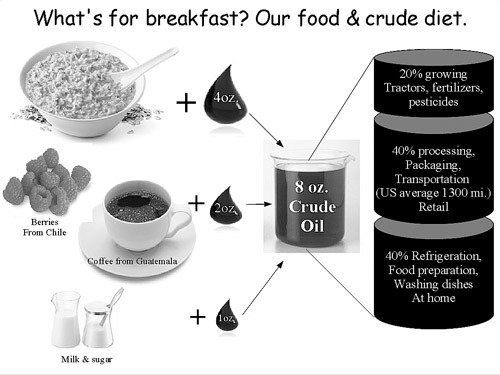By Chom Sangarasri Greacen and Faith Van De Putte
Special to the Islands’ Weekly
What did you eat for breakfast?
We think of sun, rain and soil being the basis of our food chain but the typical American diet is essentially dripping with oil.
According to University of Michigan’s Center for Sustainable Agriculture, an average of seven calories of fossil fuel is burned for every calorie of food we eat in the U.S.
This means growing, processing, and delivering the food consumed by a family of four requires the equivalent of 930 gallons of gasoline per year.
How does all that fossil fuel get embedded in our food?
It starts on the average farm with machinery and inputs. A study by David Pimentel at Cornell University reveals 30% of fossil-fuel expenditure on conventional (non-organic) farms is found in chemical fertilizer.
An organic farm may have less of a fossil-fuel footprint, unless they rely on manure or other inputs trucked in from long distances. Many do.
Some foods take far more energy, grain-fed beef for instance, which requires thirty-five calories for every calorie of steak and burger produced. In general, plant calories take less energy than animal calories.
There is often a long journey between farm and fork. Oil fuels that journey. The National Sustainable Agriculture Information Service estimated that processed food now travels an average of 1,300 miles. Some, like imported frozen shrimp and tuna, travel more than 8,000 miles to get here.
Cleaning, cooking, refrigerating, canning and packaging food before it arrives to the store all take energy and add up to a larger footprint.
The good news is that an energy efficient diet dovetails with familiar guidelines for healthy eating. It is a win- win situation!
What can you do?
First, eat low on the food chain. Seasonal, regional fruits and vegetables take less fossil fuel energy to produce. Grass-fed and “free range” critters have one third the embedded energy as their feedlot brethren.
Second, eat less processed food. In general, the more packaging and processing — the more energy required and the fewer remaining nutrients.
Thirdly, eat local. We have so many choices on Lopez for delicious, fresh island food. The options for local protein range from wild seafood and venison to quality eggs and meat from our backyard or local farms. We have community supported agriculture (CSA) programs, farm stands, roadside egg boxes and generous neighbors.
We also make choices at the grocery store. Before purchasing, look to see- where did the food come from. It matters.
Lastly, grow your own food. Gardening tends to use less fossil fuels than large-scale farming. The hard work of growing a garden is an investment with great return; fresh, healthy, low-impact food. It is not only good for you but good for the planet!
Energy conservation is not just about light bulbs, it is about lifestyle choices and who knew it could be both healthy and yummy.
Now, what is for breakfast?



